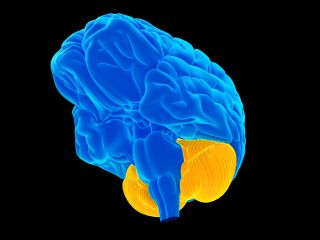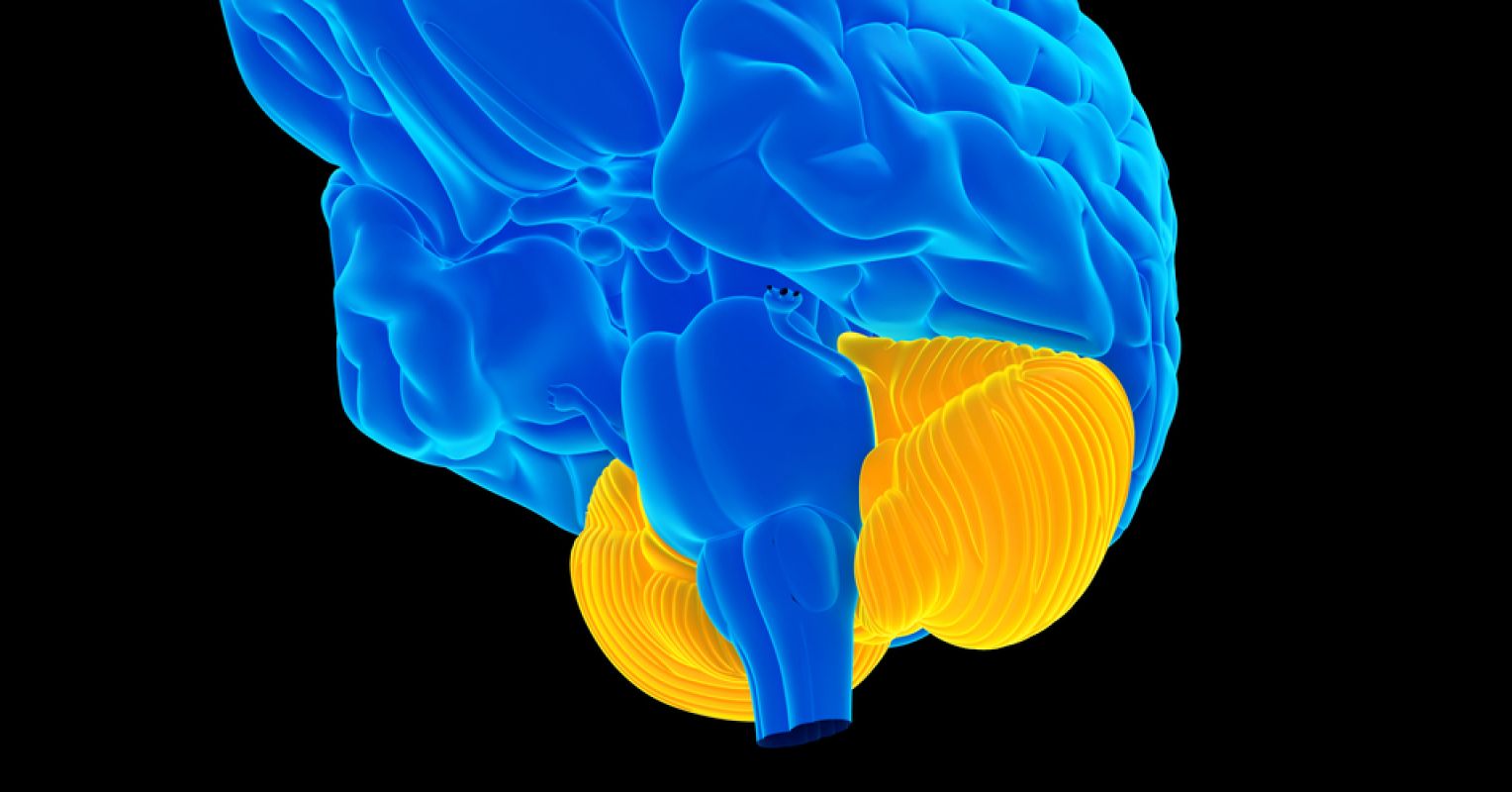
Cerebellum in orange. Cerebellar means “relating to the cerebellum.” It’s the sister word to cerebral, which means “relating to the cerebrum.”
Source: Sebastian Kaulitzki / Shutterstock
Neuroscientists have long recognized the cerebellum as essential for coordinating smooth, fluid movements in athletics and moments of peak performance. It also helps you perform everyday tasks that rely on muscle memory—such as driving a car or riding a bike—with automaticity and without overthinking what you’re doing.
In recent years, groundbreaking research has unearthed the cerebellum’s previously unknown role in language processing, superfluid thinking, and people’s social life. Accumulating evidence suggests that specialized cerebellar regions contribute to higher-order cognition, including the ability to predict and navigate complex social situations.
A Historical Perspective on the Cerebellum’s Role
Historically regarded as the brain’s motor control center, the cerebellum (Latin for “little brain”) was once thought of as a motor-function-only brain region. Its involvement in non-motor functions, particularly social cognition, wasn’t unearthed until relatively recently.
In the 1990s, researchers began uncovering the cerebellum’s hidden connection to smoother, more fluid social dynamics. Today, we know that just as the cerebellum ensures smooth, fluid movements and prevents physical clumsiness, it also supports social smoothness—helping us navigate relationships and avoid social missteps.
New Frontiers: Cortico-Cerebellar Pathways
Three recent (2024) research papers showcase the cerebellum’s heretofore unknown role in social, linguistic, and cognitive domains:
- An October 2024 study on second-language acquisition reveals that inter-hemispheric cortico-cerebellar pathways, also known as cerebro-cerebellar circuits, link specific regions of the cerebellum to language centers in the cerebral cortex. These connections enhance the efficiency of bilingual brain function, facilitating better language processing and communication.
- Another October 2024 paper explores the cerebellum’s role in social and emotional learning. It demonstrates that the cerebellum contributes to emotion regulation, theory of mind (the ability to understand others’ mental states), and smoother interpersonal dynamics.
- A November 2024 study maps the organization of the cognitive cerebellum, identifying adjacent but distinct cerebellar regions specialized for tasks related to higher-order cognition and social intelligence.
These findings deepen our understanding of the cerebellum as a multifunctional hub that collaborates with the cerebrum to optimize language abilities, social behavior, and higher-order cognitive functions.
Cerebellar Specialization in Language and Social Skills
The first study mentioned above demonstrates that early second-language acquisition in bilingual individuals depends on the cerebellum to fine-tune inter-hemispheric pathways. The cerebellum optimizes language processing while reducing cognitive load on the cerebrum by synchronizing activity between the cerebral hemispheres (“left brain-right brain”) and both cerebellar hemispheres.
The second study links specific cerebellar circuits to social and emotional learning. These neural circuits are involved in recognizing and understanding others’ emotional states using theory of mind—the ability to put yourself in someone else’s shoes.
The third study identifies distinct functional zones within the cerebellum, such as Crus I and Crus II, specialized for tasks like language processing and social cognition. Mapping these regions highlights how the cerebellum balances its multifaceted roles, from motor coordination to advanced cognitive and social functions.
Predicting Behavior: The Cerebellum’s Secret to Social Finesse
A unifying theme across these studies is the cerebellum’s reliance on predictive coding—the brain’s ability to anticipate outcomes based on prior experience and incoming sensory data.
The cerebellum helps people navigate complex social scenarios by predicting outcomes during social interactions. This includes interpreting subtle conversational cues, anticipating group dynamics, and adjusting behavior to minimize social missteps.
Specific cerebellar regions act as a “predictive engine,” enabling smoother interactions by enhancing social grace (savoir-faire) and helping to avoid awkward moments or inappropriate remarks (faux pas). Cultivating an intuitive knack for saying the right thing at the right time is rooted in the cerebellum.
Cognition Essential Reads
During motor control, predictive coding allows for smooth, precise movements by leveraging muscle memory. In social contexts, it enables individuals to anticipate conversational turns, detect sarcasm, and gracefully navigate ambiguous or potentially awkward situations.
Consider the challenges faced by individuals with autism spectrum disorder (ASD), who often struggle with predictive coding during social interactions. Research suggests that enhancing predictive coding mechanisms in the cerebellum through transcranial electrical stimulation (tES)—including techniques such as transcranial direct current stimulation (tDCS), transcranial random noise stimulation (tRNS), or transcranial alternating current stimulation (tACS)—may help mitigate these difficulties and improve subconscious social skills.
Practical Implications: From Therapy to Technology
The therapeutic potential of cerebellar stimulation represents a promising frontier. Non-invasive techniques like transcranial magnetic stimulation (TMS) are being investigated for their ability to modulate cerebellar activity and optimize how the cerebellum functions.
Stimulating regions such as Crus I and Crus II may enhance whole-brain efficiency, offering potential benefits for individuals living with ASD, social anxiety disorder (SAD), or other maladaptive personality traits that affect one’s social life and relationships.
As professor Frank Van Overwalle, from the Brain, Body and Cognition research group at the Vrije Universiteit Brussel (VUB), explains in an October 2024 news release:
“We’ve seen improvements in the sequence of cognitive tasks in people with autism through [transcranial] magnetic stimulation. We’re now testing more complex tasks to see if these effects can be further enhanced, with the ultimate goal of developing practical treatments for people with autism.”
Targeting cerebellar regions involved in emotional learning could improve the ability to interpret facial expressions and vocal tones. Similarly, stimulating language-related cerebellar circuits may enhance social communication skills. These approaches underscore how advancing our understanding of the cerebellum’s specialized zones could refine laser-focused treatments.
The Road Ahead: Optimizing Whole-Brain Connectivity
This recent research suggests that the cerebellum plays a vital role in facilitating smoother social interactions. By identifying the cerebellum’s contributions to cognition and social behavior as part of a larger, interconnected system, scientists are uncovering ways to improve whole-brain connectivity. These advances could lead to more harmonious relationships and fewer awkward social moments for all of us.




